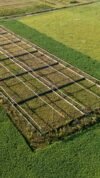Enclosures are mentioned in EFSA 2023 (see 7.2) as new higher tier option.
We negotiated about 10 years ago alternative small mammal study designs to gain useful data for the higher tier risk assessment besides field studies and modelling approaches with various stakeholders including authorities. As a result we set up enclosures and use these small mammal ‘mesocosms’ particulary for vole species in addition to various other field study options. These enclosure studies allow the observation of small mammal populations under controlled conditions, regardless of natural population dynamics throughout a given year, early or late in the season. They facilitate the collection of individual-based effect- and exposure data or generic data for risk assessment purposes.
You are currently viewing a placeholder content from Youtube. To access the actual content, click the button below. Please note that doing so will share data with third-party providers.
More InformationEnclosures are common test systems in scientific research involving small mammals such as voles. They ensure that there is neither migration nor predation. With the ability to intensively monitor an individually known starting population, regulatory-relevant toxicological endpoints can be examined and addressed directly within an enclosure study. Furthermore, early or late application scenarios difficult to cover in the wild can be simulated as well as any other kind of specific set up regarding time, species, ground cover, exposure (pattern) etc.. RIFCON currently offers 22 enclosure boxes to conduct smaller (up to 10) or larger (up to 22) enclosure studies for your needs.
If you have questions just let us know!
We are here to help!
Find out how we can specifically support you in successfully using enclosure studies as part of your registration data package
What can we do for you?
Exposure- and Effect Studies
- investigation of potential acute and/or long-term effects on small mammals
- Toxicological aspects: Verification of laboratory findings in enclosure set-ups
Feeding Trials
- for example, to examine avoidance behaviour
Individual Study Designs
- individual data collection on population, offspring, weight development, reproduction, etc.
- investigation of detailed or specific exposure patterns
- covering of very early exposure timings (March/April)



